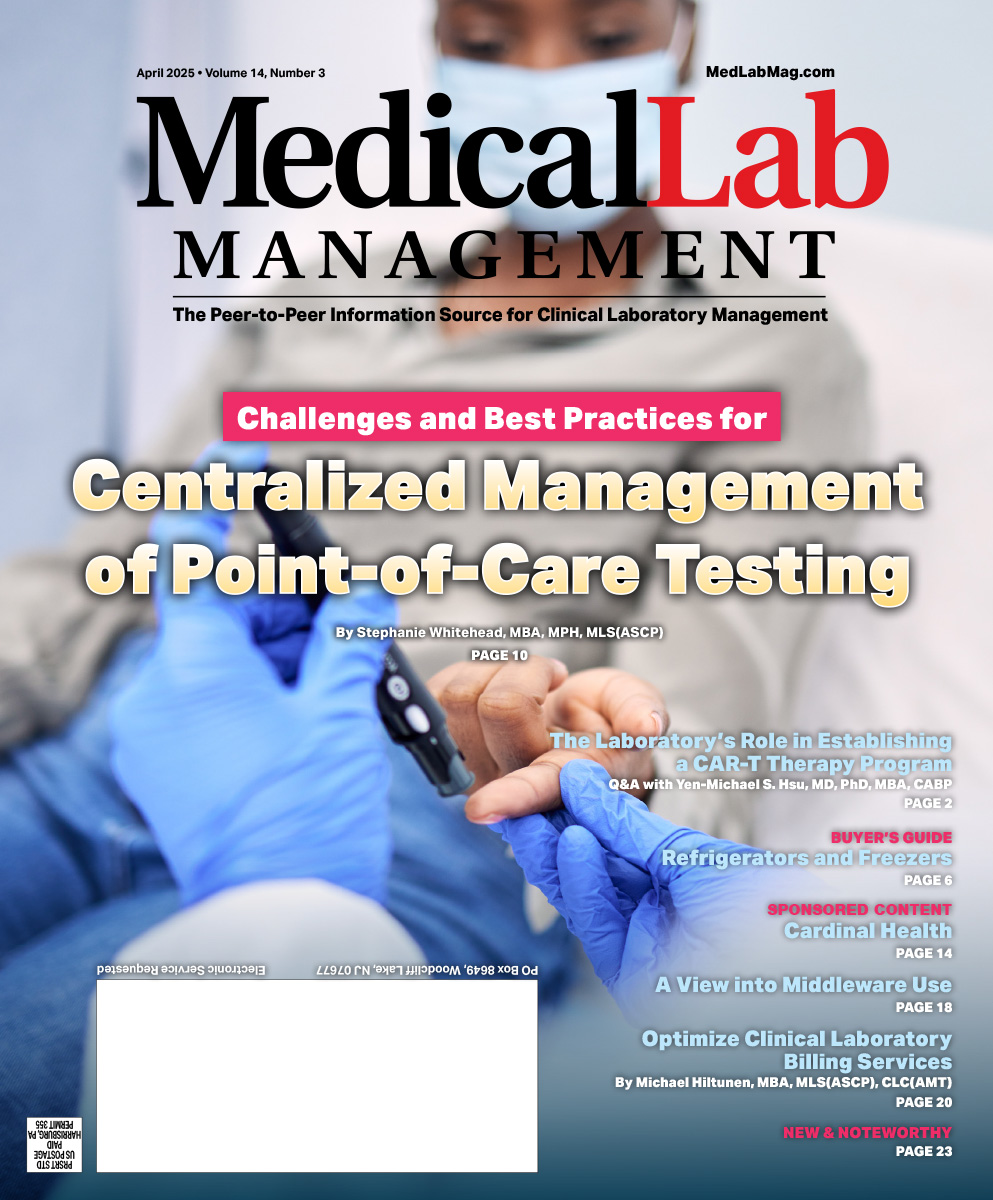- Show Menu
- Contact Us
- FAQs
- Reader Service
- Survey Data
- Survey Winners
- Testimonials
- Upcoming Events
- Webinars
Merge AI and Clinical Chemistry

While approximately 16% of clinical laboratory medicine stakeholders currently use some form of artificial intelligence in their laboratories, over 66% of the same stakeholders consider AI to be a real possibility for their institution.1 Preference aside, it is difficult for anyone in the laboratory profession to ignore the post-pandemic clinical laboratory landscape. Not even the surveyed American public’s skeptical sentiment toward AI’s ability to diagnose disease or impact overall health outcomes can override staggering personnel shortages, lingering manually intensive processes, and underutilized data.2 That said, reliance on increasingly sophisticated instruments and automation in the laboratory will continue, not abate, in the years to come and AI will most certainly be incorporated in this process.
AI and Automation in the Lab
Recent AI integration into the clinical laboratory has centered on molecular and digital pathology, and for good reason.3 Chemistry and immunology are a tempting next step, with a treasure trove of structured data and “rule in/rule out” decision-support applications.4 Further, these laboratory divisions are no stranger to the benefit of automation. Recent literature expounds heavily on the impact of automation lines in reducing result variability, technologist error, overall workloads, and time consumption.5 Laboratories choosing to utilize automation can also leverage robust, cloud-based middleware solutions with potential AI features.
These systems are already deployed in clinical laboratories with extensive rules packages and analytic capabilities. For these reasons, AI in the clinical chemistry and immunology departments has potential applications with internal operations, as well as with external relations to multidisciplinary teams in the provision of data beneficial to holistic clinical algorithms. An example of this involving acute kidney injury (AKI) is discussed below.
Operational Benefits
Among the primary operational benefits of embedded AI is the ability to eliminate managerial guesswork adjustments for staffing resources. Computational analysis of monthly, quarterly, or annual test volume by the literal second can illuminate patterns in real time. This information can then facilitate both a predictive and prescriptive staffing model. Alternatively, AI can help optimize reagent material inventory by analyzing historical purchasing and stock against time and use trends. Likewise, AI could incorporate trending in supplier reagent availability, technical bulletins, recalls, and customer feedback.
Other operational applications of AI involve equipment monitoring and predictive modeling, the incorporation of which can help save time and money by reducing incidences of equipment failure and downtime.
Each of these operational applications are currently under investigation and/or are involved in active testing in other industries; as an example, AI is being utilized in waste management of biohazardous materials with smart waste bins that incorporate computer vision, robotics, and machine learning to efficiently and accurately sort waste at the time of disposal.6 It is reasonable that if success is observed within these outside markets, the clinical laboratory’s industry partners will take notice and seek to capitalize.
Challenges to Implementation
In general, the heaviest lifting for clinical chemistry and immunology practitioners originates within the areas of quality control, specimen integrity, and result interpretation. And heretofore, ethical concerns have been raised that AI may only serve to automate inaccuracy in these modalities due to their underlying complexities.7 As such, creating AI applications that satisfy rigorous methodological scrutiny in these areas would necessitate deep-learning systems, such as deep neural networks (DNNs), which are capable of weighing decision making variables. However, this technology remains in a growth state requiring esoteric knowledge and training, and it often incorporates proprietary “black box” algorithms.
Regardless, the precision and accuracy of visual AI (computer vision) has progressed rapidly in recent years. Many laboratory automation lines now contain cameras that capture detailed images of test tubes, post centrifugation to detect the presence of lipemia, icterus, or hemolysis. It is now highly plausible that such technology could be augmented to include a computational analysis. This would allow for upstream evaluation and exclusion of compromised specimens prior to the analytical process.
Quality Control and AI
Training data sets and end-user validation are essential pieces of a quality control AI (QC AI) program. As an example, Westgard rule decision triggers are well defined, and programming fixed logic is attainable. However, regional preferences and end-user variability are not as clear cut. Algorithmic bias could be introduced based on lack of standardization across local laboratories and could result in unintended harm, such as lot-to-lot variability, which not only negatively impacts the laboratory’s ability to provide consistent results over time, but could also skew how the AI algorithm learns. Conversely, when considering systemic problems of unequal access, a robust, AI-supplemented QC solution could provide rural access facilities, for example, with a streamlined method to enhance quality programs.
Newer technologies, such as mass spectrometry, could be more easily developed, validated, and implemented by a larger clinical laboratory share if AI could augment the interpretative process. In laboratories with total automation solutions, AI algorithms could be utilized to compare, recommend, or predict chemistry findings across connected platforms at the patient level. A recent example is the creation of a neural network model that predicts serum iron levels from parameters within a complete blood count to foresee iron-deficiency anemia.4
Additionally, AI allows for larger practice conversations on patient-based reference ranges and patient-based real-time QC. These concepts have gained attention as an alternative for today’s binary-derived population-based ranges and current internal QC programs.8
A Look Ahead
Today, more than 500 healthcare AI algorithms are now approved by the FDA.9 While over 75% of these involve medical imaging, the ability of AI to learn patterns of diseases is rapidly evolving.9 Clinical laboratories should be aware that healthcare AI tools may need a specific result to produce a prognostic evaluation. As an example, AKI incidence continues to increase with short- and long-term care outcome implications.10 In response, predictive risk modeling for AKI has emerged as a central focus in laboratory integrative AI algorithms with several chemistry biomarkers in the decision matrix.10 Another developing application involves support for hepatology and patients with liver conditions via prognostic algorithm roadmaps that are inclusive of laboratory biomarkers.11
Conclusion
As external AI applications continue to improve, it is imperative for laboratory professionals to gain transparency when enterprise AI tools are being considered and actively participate in the validation process. Soon, the clinical laboratory may be the entity informing stakeholders of built-in AI technology on instrumentation instead of the current ad-hoc environment. Regardless, laboratory subject matter expertise is necessary for safe and ethical AI integration. Thus, laboratory leaders should make every effort to learn about AI advancements involving their division. The examples listed in this article present a subset of those with clinical chemistry and immunology impacts to encourage readers to explore the literature.
References
- Paranjape K, Schinkel M, Hammer RD, et al. The Value of Artificial Intelligence in Laboratory Medicine: Current Opinions and Barriers to Implementation. Am J Clin Pathol. 2020;155(6):823-831. doi:10.1093/ajcp/aqaa170
- Tyson A, Pasquini G, Spencer A, Funk C. Pew Research Center; February 22, 2023. pewresearch.org/science/2023/02/22/60-of-americans-would-be-uncomfortable-with-provider-relying-on-ai-in-their-own-health-care/
- Baxi V, Edwards R, Montalto M, Saha S. Digital Pathology and Artificial Intelligence in Translational Medicine and Clinical Practice. Mod Pathol. 2022;35(1):23-32. doi:10.1038/s41379-021-00919-2
- Blum K. A Status Report on AI in Laboratory Medicine. Clin Lab. Published online January 1, 2023. aacc.org/cln/articles/2023/janfeb/a-status-report-on-ai-in-laboratory-medicine
- Kumar V, Dip Gill K. Automation in Clinical Laboratory. In: Basic Concepts in Clinical Biochemistry: A Practical Guide. Springer, Singapore; 2018:13-15.
- How AI is Revolutionizing Waste Management. CleanRobotics. June 30, 2022. Accessed June 16, 2023. cleanrobotics.com/how-ai-is-revolutionizing-waste-management/
- Westgard Trends. Is the future of laboratory AI Automating Inaccuracy? Westgard QC. Accessed June 14, 2023. westgard.com/ai-automated-inaccuracy.htm
- Zhou R, Wang W, Padoan A, et al. Traceable Machine Learning Real-Time Quality Control Based on Patient Data. Clin Chem Lab Med. 2022;60(12):1998-2004. doi:10.1515/cclm-2022-0548.
- U.S. Food and Drug Administration. Artificial Intelligence and Machine Learning Enabled Medical Devices. FDA. Revised October 5, 2022. Accessed June 12, 2023. fda.gov/medical-devices/software-medical-device-samd/artificial-intelligence-and-machine-learning-aiml-enabled-medical-devices.
- Gameiro J, Branco T, Lopes JA. Artificial Intelligence in Acute Kidney Injury Risk Prediction. J Clin Med. 2020;9(3):678. Published 2020 Mar 3. doi:10.3390/jcm9030678
- Nishida N, Kudo M. Artificial Intelligence Models for the Diagnosis and Management of Liver Diseases. Ultrasonography. 2023;42(1):10-19. doi:10.14366/usg.22110

Melody Boudreaux Nelson, MS, MLS(ASCP)CM, is the laboratory information systems manager at The University of Kansas Health System in Kansas City, Kansas. She received her master’s degree in clinical laboratory management from RUSH University in 2019 and has served in laboratory administration roles since 2017. Melody is currently a resident in the Doctor of Clinical Laboratory Science program through the University of Kansas Medical Center. She also sits on the Council of Laboratory Professionals through the American Society for Clinical Pathology. Melody’s experience in laboratory leadership includes oversight roles in core laboratory, operational management, and informatics.
Like what you've read? Please log in or create a free account to enjoy more of what staging.medlabmag.com has to offer.








